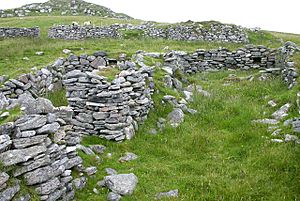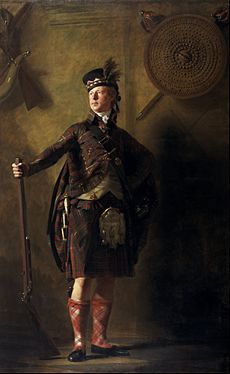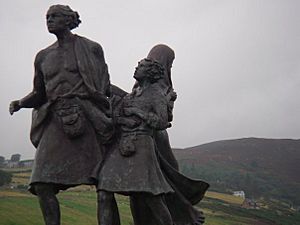Highland Clearances facts for kids

Ruined croft houses on Fuaigh Mòr in Loch Roag. The island was cleared of its inhabitants in 1841 and is now used only for grazing sheep.
|
|
| Date | Mostly 1750 – 1860 |
|---|---|
| Outcome | Emigration from the Highland region Crofters Holdings (Scotland) Act 1886 |
The Highland Clearances (Scottish Gaelic: Fuadaichean nan Gàidheal, meaning "the eviction of the Gaels") were a sad time in Scottish history. Many people living in the Scottish Highlands and Islands were forced to leave their homes. This happened mostly between 1750 and 1860.
At first, landlords wanted to make more money from their land. They changed the old farming ways to large sheep farms. This meant many families, who had lived there for generations, had to move. They were often expected to find new jobs in fishing or other industries. Their lives changed from farmers to crofters, which meant they had less land and less status.
Later, many crofting communities became too crowded. People struggled to support themselves, especially when industries like kelp (seaweed) farming failed. There were also terrible famines, like the Highland Potato Famine. During this time, landlords often paid for their tenants to leave Scotland and move to other countries. This was called "assisted passage." For many, leaving was their only choice.
These evictions went against an old Highland idea called dùthchas. This meant that clan members had a right to live on and rent land in their clan's area. However, Scottish law did not recognize this right. Clan chiefs started to see themselves as landowners, not just leaders of their people. This difference in how people saw things caused a lot of anger and sadness.
Contents
What "Clearance" Means
The word "clearance" became popular later on. It describes when Highland landlords moved people off their land. Sometimes it meant a whole village was moved at once. Other times, it was just one family at the end of their lease. Today, it generally means any time people were displaced by landlords in the Highlands. This includes both forced and voluntary moves, whether people moved nearby or emigrated far away.
Why the Clearances Happened
Changes in Farming
The first part of the Clearances was linked to big changes in farming. This was part of the Scottish Agricultural Revolution. Cities were growing and needed more food. Landlords saw their land as a way to make more money.
Before these changes, Highland farming used a system called run rig. Families shared open fields and common land for grazing animals. People lived in small villages called bailtean. With no individual leases, there was little reason for farmers to improve the land. Landlords wanted to change this. They started to enclose common lands and replace mixed farming with large-scale sheep farming. This meant fewer people were needed to work the land. The displaced people often had to move to smaller plots of land called crofts, or leave the area entirely.
Clan System Changes
For centuries, clans were the main social groups in the Highlands. A clan chief led the clan, and his family members held important positions. Clans offered protection and land to their members. In return, clansmen provided service, including military service, and paid rent, often with goods rather than money.
Over time, kings like James VI and I wanted more control over the Highlands. Laws like the Statutes of Iona in 1609 made clan chiefs spend more time and money in Edinburgh. This made them act more like landlords and less like traditional clan leaders. They started to think of their land as something to make money from, not just to support their people.
End of the Tacksmen
Tacksmen were important people in the old clan system. They leased land from the chief and then rented it out to smaller farmers. They were often related to the clan chief and helped manage the Highland economy.
Landlords started to limit the tacksmen's power and raise rents. This was part of slowly getting rid of their role. Many tacksmen and larger farmers left Scotland, often moving to America. This meant the Highlands lost many skilled and entrepreneurial people.
Phases of the Clearances
First Phase (1760-1815)
The first phase involved breaking up the traditional villages (bailtean). Instead, individual small farms called crofts were created. People were often moved from inland valleys to the coast. There, they were expected to find work in new industries like kelp (seaweed) or fishing. The land they left behind was turned into large sheep farms. So, this phase was more about moving people to new places rather than completely expelling them.
Second Phase (1815-1850s)
This phase began after the Napoleonic Wars ended. Industries like kelp farming collapsed, and the population kept growing. This made things very difficult for many communities.
Landlords began to force people off their estates. They often offered "assisted emigration," paying for families to travel to North America or Australia. This meant cancelling any rent they owed and paying for their journey. The Highland Potato Famine (1846-1855) made this process even more urgent.
Regional Differences
The Clearances affected different parts of the Highlands in different ways.
- Southern and Eastern Highlands: Here, land was enclosed and rented to fewer tenants who had larger farms. These farms still needed workers, so some former tenants found jobs as farm servants or labourers. The population here didn't grow much because people could move to the Lowlands for work.
- Hebrides and Western Coastal Areas: This became known as the "crofting region." Large areas were turned into sheep farms, which created very few jobs. People were moved to small crofting communities on the coast. They were meant to work in fishing or kelp industries. However, crofts often became overcrowded, and the kelp market collapsed. This left many communities with not enough land to grow food and no jobs. This area was hit hardest by the potato famine.
Main Reasons for the Clearances
Life in the Highlands was always tough, and famine was a constant danger. Even so, the population grew steadily. People left the Highlands before and during the Clearances, and even more so afterwards.
Economic Changes
Landlords could make much more money by replacing old-style farming with large sheep farms. These new farms paid higher rents. It also meant fewer tenants to manage, which was easier for the landlords.
Some land was also cleared for deer hunting estates. Sometimes, land was cleared for sheep, and then cleared again later for deer. But the biggest change was to sheep farming. The best sheep for profit were Cheviots, but they needed low-level land for winter, which was often the old farmland of the evicted people.
Social Engineering
Some people involved in the Clearances believed they were helping the affected people. For example, Patrick Sellar, a manager for the Countess of Sutherland, thought that forcing people to move would make them work harder and improve their lives.
New homes were often planned for the cleared tenants, like in the Sutherland Clearances. People were moved to crofts on the coast. The idea was that these small plots of land wouldn't be enough to live on, so people would have to find other jobs like fishing. Losing their status as farmers and becoming crofters was a big reason for the anger about the Clearances.
Building new towns and industries for the displaced people required a lot of money. This money often came from wealthy people who had made their fortunes outside Scotland. However, these investments often didn't make much profit.
Kelp Industry Failure
The kelp (seaweed) industry was very important in the Hebrides. Seaweed was harvested, dried, and burned to make a chemical used in soap and glass. It provided many jobs, especially in the Western Isles.
However, after the Napoleonic Wars ended in 1815, the kelp trade collapsed. Cheaper products from other countries and new ways to make the chemical destroyed the industry. This meant 25,000 to 40,000 crofters lost their seasonal jobs. The population of the Western Isles had grown a lot, so this economic collapse led to widespread poverty. Many landlords also fell into debt and bankruptcy.
Famine
The Highlands was always at risk of famine. The population increased, but so did the risk of not having enough food. People relied on trade, exporting cattle and importing oatmeal.
In the early 1800s, crofting communities became more common. Especially in the West Highlands, people relied on potatoes for most of their food. Potatoes had a much higher yield than oats.
A severe potato blight arrived in Scotland in 1846, causing the Highland Potato Famine. This was a much worse and longer famine than any before. Many people had nothing to eat. The government and charities helped, and some landlords tried to support their tenants. But many landlords, already in debt, went bankrupt trying to provide relief.
The famine made clearances and emigration seem like the only solution. Landlords and the government felt they had to reduce the population. Between 1846 and 1856, almost 11,000 people received "assisted passages" from their landlords to emigrate. Thousands more paid their own way or were helped by other groups.
Landlord Debt
Many Highland landlords were deeply in debt. This was due to various reasons:
- Some debts went back centuries, as landlords had to spend money living in Edinburgh.
- Many spent too much money.
- The low productivity of Highland land made it hard to earn enough.
- Providing famine relief also drained their money.
- Investments in improving their estates often didn't pay off.
- The end of the Napoleonic Wars meant lower prices for Highland goods, reducing their income.
By the 1850s, over two-thirds of Highland estates had been sold because of debt. New owners often had plans for "improvement" that included clearing tenants. They also had money to pay for assisted passages for people to emigrate. These new owners often didn't understand the old Highland idea of dùthchas, so tenants lost that protection. If a landlord went bankrupt, the estate was managed by lawyers whose only job was to protect the creditors' money, with no concern for the tenants.
Overpopulation
The 18th century saw a lot of population growth. At first, landlords saw more people as a good thing, providing workers and soldiers. The government even tried to stop people from emigrating. The Highlands provided many soldiers for the British army during various wars.
However, in the 19th century, attitudes changed. When the kelp trade collapsed, many people lost their jobs and faced poverty. Landlords, or those managing bankrupt estates, started to encourage or even force people to emigrate. The potato famine made this even more urgent. The government made it clear that landlords were responsible for feeding their starving tenants. This pushed landlords to support emigration as a way to reduce the number of people they had to support.
By the 1840s, many believed the Highlands had too many people. The idea was that large-scale emigration was the solution to the social crisis.
Discrimination
While the main reason for the Clearances was economic, some people also held prejudiced views. Some believed that Celtic people (Highlanders) were less hardworking than Anglo-Saxon people (Lowlanders or English). People like Patrick Sellar and Sir Charles Trevelyan held these views. This racism against Gaels certainly played a part.
Religious discrimination against Roman Catholics also existed, but historians generally don't see it as a main reason for evictions during the Clearances. It was more a reason for some Catholics to choose to emigrate voluntarily.
Key Events and Examples
Year of the Sheep (1792)
In 1792, tenant farmers in Strathrusdale protested by driving over 6,000 sheep off the land. This was one of the first big protests against the Clearances. Landlords were replacing mixed farms with sheep farms, and the sheep were causing problems for the remaining tenants' cattle. The protest was well-organized, with thousands of sheep gathered and driven south.
Local landowners and law officers were worried, especially with the French Revolution happening. Soldiers were called in. Most protestors fled, but some were caught. While some were found guilty of minor charges, the punishments were light. This protest showed early resistance to the changes.
The Sutherland Clearances
The Sutherland estate was huge, covering much of Sutherland. Elizabeth Sutherland inherited it as a child. The estate was in debt, but when her husband inherited a large fortune in 1803, they had money for "improvements." Lady Sutherland took an active role in managing the estate. She and her advisors believed that moving people to the coast and starting new industries like fishing would be good for everyone.
Patrick Sellar's Role
In 1809, Patrick Sellar became a key advisor to the Sutherland estate. He and William Young had ambitious plans to quickly change the estate. They introduced new industries like coal mining and fishing villages.
The first major clearances under Sellar were in Assynt in 1812. People were moved to the coast to make way for large sheep farms. In 1813, there were riots in Strath of Kildonan when sheep farmers tried to view the land. The army had to be called in, and the estate made some concessions. Lady Sutherland was surprised by the resistance, as she thought her plans were helpful.
More clearances were planned for Strathnaver in 1814. Sellar himself leased one of the new sheep farms, which meant he was responsible for clearing the land he would then use. During these evictions, houses were burned to prevent people from moving back in. There was a terrible incident where an elderly, bedridden woman might have been in her house when it was set on fire. She died a few days later. Sellar was charged with serious crimes but was found not guilty in 1816. This event, and Sellar's actions, became a symbol of the harshness of the Sutherland Clearances.
James Loch's Management
After Sellar left his management role, James Loch took over. He wanted to avoid more public outrage. He instructed that rent arrears could be forgiven for those who cooperated, and new croft rents should be low.
The biggest part of the Sutherland clearance program happened from 1818 to 1820. In 1819, houses were again burned, causing a huge public outcry. This year became known as "the year of the burnings" (bliadhna na losgaidh). Newspapers reported on "the Devastation of Sutherland."
Despite the protests and bad publicity, the clearances continued. However, the Sutherland estate did offer resettlement options, which was more than some other landlords did. By 1821, the major clearance activity on the Sutherland Estate mostly ended.
Glengarry Clearances

Alexander Ranaldson MacDonell of Glengarry was a clan chief who claimed to support Highland culture. However, he also forced his tenants, mostly Catholic, to leave their homes. Many of his former soldiers and their families moved to Glengarry County, Ontario in Canada.
Resistance to the Clearances
Many people think Highlanders didn't resist the Clearances much, but this isn't true. There were many acts of resistance. Soldiers were called in at least 10 times. While no deaths were directly caused by the evictions themselves, there were over 50 major protests.
Women often led the resistance, with men supporting them. People would confront law officers and destroy eviction notices. Shepherds brought in for the new sheep farms were threatened, and sheep were stolen or harmed. People also continued old practices like poaching.
After the Disruption of 1843, many Gaelic-speaking areas joined the Free Church. This church often criticized landlords and refused to take money from them.
Crofters' Act
The Highland Land League worked to get land reform. This led to the Crofters' Holdings (Scotland) Act 1886. This law gave crofters security of tenure, meaning they couldn't be easily evicted from their land. This act finally put an end to the Clearances.
However, the act didn't help the very poorest people (cottars) or break up the large estates. Scotland still has a very unequal distribution of land, with a small number of people owning most of it.
Legacy of the Clearances
Literature and Poetry
The Clearances are still a big topic for historians and writers. There are different views on why they happened and what their effects were.
Many writers at the time and later condemned the Clearances. Books like Alexander Mackenzie's History of the Highland Clearances (1883) helped bring attention to the landlords' power. Authors like Neil M. Gunn and Fionn MacColla wrote novels about the Clearances.
Poets also wrote about the Clearances. Some expressed sadness and nostalgia, while others, like Mary MacPherson, wrote with anger and called for action. The famous Gaelic poem Hallaig by Sorley MacLean is about a cleared village.
Many songs were written to mock the landlords. Dùthaich Mhic Aoidh (Mackay Country), by Ewen Robertson, is a famous example. It criticizes the Duke of Sutherland and his managers.
Memorials
On July 23, 2007, a bronze statue called Exiles was unveiled in Helmsdale, Sutherland. It shows a family leaving their home and remembers the people who were cleared from the area and started new lives overseas. An identical statue is in Winnipeg, Canada.
In Golspie, Sutherland, a statue of George Granville Leveson-Gower, the first Duke of Sutherland, has been vandalized because of his controversial role in the Clearances.
Demographics
The Clearances led to a worldwide spread of Highlanders. Many settled in communities in Canada (like Prince Edward Island, Nova Scotia, and Ontario) and the Carolinas in the United States. Canadian Gaelic was spoken widely for about 200 years. It's estimated that 50,000 Gaels moved to Nova Scotia between 1815 and 1870.
See also
- Crofting
- Crofters Holdings (Scotland) Act 1886
- Enclosure
- Clan MacDonell of Glengarry
- Rural flight
- Scottish Australians
- Scottish Americans
- Scottish Canadians
- Scottish New Zealanders
- Lowland Clearances
Images for kids







